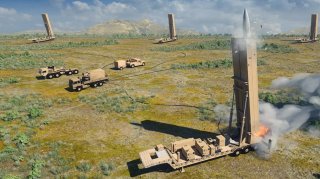Dark Eagle: The Army's New Hypersonic Missile Can Strike from 1,725 Miles Away
The Long-Range Hypersonic Weapon (LRHW), or "Dark Eagle," is a hypersonic missile system being developed by the U.S. Army to counter China's advantage in intermediate-range missiles.
What You Need to Know: The Long-Range Hypersonic Weapon (LRHW), or "Dark Eagle," is a hypersonic missile system being developed by the U.S. Army to counter China's advantage in intermediate-range missiles.
-The system comprises a Lockheed Martin rocket booster and a Dynetics Common-Hypersonic Glide Body (C-HGB), which destroys targets with kinetic energy alone, reaching speeds above Mach 5. Launched from modified M983 tactical trucks, the Dark Eagle’s deployment will include eight missile batteries, each with eight missiles.
-Other branches, including the Navy, aim to deploy it on Zumwalt-class destroyers by 2025 and Block V Virginia-class submarines by 2028. The missile will address the gap left by the INF Treaty’s restrictions, with an estimated range of 1,725 miles.
Dark Eagle: The U.S. Army’s Hypersonic Answer to China’s Missile Gap
Currently under development for the United States Army is the Long-Range Hypersonic Weapon (LRHW), also known as Dark Eagle. The Dark Eagle is an intermediate-range surface-to-surface boost-glide weapon that will help to address the U.S.’s intermediate missile gap relative to the Chinese.
Explaining the Dark Eagle
The Dark Eagle consists of two distinct parts. The first is a Lockheed Martin-built rocket booster. The second is an unpowered, Dynetics-built Common-Hypersonic Glide Body (C-HGB), situated in the rocket booster’s nose cone. The booster is launched, propelling itself to designated speeds and altitudes, at which point the C-HGB is released from the nose cone. Once released, the C-HGB glides at hypersonic speeds, upwards of Mach 5, back to Earth, towards the target.
The C-HGB is a kinetic energy projectile warhead, meaning the weapon does not contain an explosive warhead. Rather, the C-HGB relies merely upon its kinetic energy to destroy a target. To generate sufficient kinetic energy to negate the need for an explosive warhead, the C-HGB must achieve awesome speeds.
The Army plans to launch the Dark Eagle from the M983 truck and trailer. The M983 is an eight-wheel drive, diesel-powered, ten-ton tactical truck. The truck can be configured differently, depending upon the mission, and can serve in a variety of roles, everything from tactical fire truck to water tender to Common Bridge transport to missile launcher.
In the case of the Dark Eagle, the M983 will be arranged in eight missile batteries, with four trucks carrying two missiles a piece. According to the Army, “an LRHW battery consists of four Transporter Erector Launchers on modified M870A4 trailers, each equipped with two AUR+Cs, eight in total, one Battery Operations Center (BOC) for command and control and a BOC support vehicle.”
Other branches are interested in the Dark Star, too; The Navy is hoping to deploy the Dark Eagle from the Zumwalt-class destroyer by 2025 and the Block V Virginia-class submarine by 2028.
The deployment of the Dark Eagle, across branches, should help to mitigate the intermediate missile gap that China currently enjoys over the U.S.. The missile gap is a vestigial effect of the Intermediate-Range Nuclear Forces Treaty (INF Treaty), to which the U.S. was a signatory, but to which China was not. As the name implies, the INF forbade signatories from possessing, producing, or flight-testing ground-launched ballistic and cruise missiles with ranges between 310 and 3,420 miles. Missiles with such a range have immense military applications, and China stockpiled accordingly. The U.S., having now withdrawn from the INF, is playing catch up. The Dark Eagle should help bridge the gap.
Although the exact range of the Dark Eagle is classified, speculation holds that the new missiles can reach targets at ranges of about 1,725 miles.
About the Author: Harrison Kass
Harrison Kass is a defense and national security writer with over 1,000 total pieces on issues involving global affairs. An attorney, pilot, guitarist, and minor pro hockey player, Harrison joined the US Air Force as a Pilot Trainee but was medically discharged. Harrison holds a BA from Lake Forest College, a JD from the University of Oregon, and an MA from New York University. Harrison listens to Dokken.
Image Credit: Creative Commons and/or Shutterstock.


